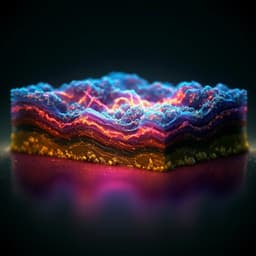
Physics
Atomic-scale imaging of laser-driven electron dynamics in solids
D. Popova-gorelova and R. Santra
This groundbreaking study by Daria Popova-Gorelova and Robin Santra introduces a novel method for probing laser-driven electron dynamics using ultrafast x-ray diffraction. By employing subcycle-resolved x-ray-optical wave mixing, they unveil intricate details of electron motion in solids, revealing the spatial and temporal behavior of optically-induced charge distributions. Discover how this technique transforms our understanding of electronic current flow in light-induced phenomena.
~3 min • Beginner • English
Introduction
Excitation by strong light fields in solids can drive processes such as optical manipulation of electronic structure and high-harmonic generation, with promise for ultrafast optoelectronics. Understanding these phenomena requires access to microscopic, temporally and spatially resolved electron dynamics, which has been hindered by interpretational challenges in wave-mixing signals, limited energy resolution on sub-femtosecond scales, and insufficient spatial resolution of standard spectroscopies. When light interacts with a crystal, charge rearrangements within the unit cell and microscopic electron currents form. On the atomic scale, induced charge distributions exhibit rich, non-dipolar structures and symmetry features. The authors introduce an ultrafast, nonresonant hard x-ray diffraction approach capable of probing, in real time, charge and current distributions within a unit cell during optical driving. Building on x-ray–optical wave mixing (XOWM), and extending it to subcycle-resolved measurements with x-ray pulses shorter than an optical period, the method leverages hard x-ray wavelengths for atomic-scale spatial resolution and temporal interference between sidebands to extract phases of optically induced charge oscillations and associated current flow.
Literature Review
The work situates itself within strong-field and ultrafast solid-state physics. Prior studies established strong-field-driven phenomena in solids and bulk high-harmonic generation (HHG), motivating petahertz electronics and attosecond nanoscopy. XOWM was proposed and demonstrated at x-ray free-electron lasers, typically in time-unresolved configurations that yield separated sidebands encoding only amplitudes of density Fourier components. Recent advances in generating ultrashort, even attosecond, x-ray pulses open routes for real-time probing of electron motion. However, standard time-integrated XOWM lacks phase information, leading to a crystallographic phase problem. The present study addresses this gap by showing that subcycle-resolved XOWM provides both amplitudes and phases of the Fourier components of optically induced charge oscillations, enabling full reconstruction of charge distributions and inference of current flow, and by connecting momentum-symmetry breaking in time-resolved scattering to microscopic currents as suggested in related pump–probe theories.
Methodology
System and driving: The authors consider alpha-quartz (α-quartz, chiral, space group 152) driven by a periodic optical field. Baseline case: photon energy 1.2 eV, intensity 1e12 W/cm^2, polarization along (1,1,0). The second-order polarization is along (0,1,0) per the crystal class 32 susceptibility tensor. HHG has been demonstrated in α-quartz for similar parameters.
Theoretical framework: The total Hamiltonian includes the crystal, optical interaction, x-ray interaction, and free-field parts. Optical interaction is treated in the dipole approximation, keeping the A·p term and neglecting A_o^2. X-ray interaction is nonresonant in the hard x-ray regime; the dominant A_x^2 term is used for elastic and inelastic nonresonant scattering; the resonant A_x·p term is neglected. The total x-ray scattering probability is split into quasielastic (P_qe) and inelastic (P_inel) parts; for α-quartz, P_inel is two orders of magnitude smaller than P_qe in the relevant spectral range.
Time-unresolved XOWM: With probe pulses longer than an optical period, XOWM yields isolated side peaks at ω_out = ω_in ± μω around Bragg peaks at reciprocal lattice vectors G, with intensities proportional to the squared modulus of the Fourier components of the μth-order density oscillation amplitudes.
Subcycle-resolved XOWM: For a Gaussian x-ray probe with duration τ_p shorter than the optical period (e.g., τ_p ≈ 2.35 fs for ω = 1.2 eV, optical period ≈ 3.4 fs), neighboring sidebands spectrally overlap, producing interference terms in P_qe(ω,G,t_p) that are time dependent. The general expression (their Eq. 3) yields sums over Gaussian-weighted sidebands and their pairwise interference, leading to temporal oscillations at Δμ ω centered between sidebands at ω_in + (μ+1/2)ω. The probe arrival time t_p sets the phase of the temporal evolution.
Symmetry analysis: Decomposing the signal into centrosymmetric and antisymmetric parts in momentum space reveals direct connections to electron density and current density oscillations. For time-reversal symmetric materials (like α-quartz), even-order density amplitudes are real and odd-order are purely imaginary, fixing their phases and leading to: (i) antisymmetric part of P_qe evolves as cos(ω t) (or more generally cos(Δμ ω t) for odd Δμ and sin(Δμ ω t) for even Δμ), correlating with electron-current density oscillations; (ii) centrosymmetric part evolves as sin(ω t) (generalized accordingly), correlating with electron density oscillations.
Phase and amplitude retrieval: Writing the Fourier transform of the real-valued density amplitude ε_u(r) as P_u(G) = |P_u(G)| e^{i α_u(G)}, the time-dependent interference between sidebands (e.g., main peak–first sideband at ω_in + ω/2) oscillates as sin(ω t + α_0(G) + α_1(G)), enabling extraction of α_1(G) given α_0(G) of the unperturbed density (known for a material with known structure). Subsequent interferences (e.g., first–second at ω_in + 3ω/2) yield α_2(G), and so on. The time-independent part gives |P_u(G)|^2 at each order u. Measuring at multiple G allows reconstruction of ε_u(r) for accessible orders.
Current reconstruction: Using the continuity equation div j_u(r) = −u ω ρ_u(r) and Green’s first identity, the Fourier components satisfy i G·J_u(G) = −u ω P_u(G), enabling retrieval of projections of current Fourier components (including phase). The sign gives current direction; phase gives spatial symmetry features.
Computational details (Methods): Kohn–Sham wave functions computed with ABINIT using PBE GGA and optimized norm-conserving Vanderbilt pseudopotentials. 24 valence and 216 conduction bands on a 16×16×16 k-grid. Floquet–Bloch Hamiltonian constructed from these states (141 Floquet blocks, each 240 states), increased until convergence. Scissors correction adjusts band gap from 6.1 eV to the experimental 8.9 eV. Optically induced charge and current densities computed per prior work and visualized in VESTA. The selected α-quartz structural chirality corresponds to space group 152.
Key Findings
- Subcycle-resolved x-ray–optical wave mixing (XOWM) with a 2.35 fs hard x-ray probe provides temporal interference between neighboring sidebands, enabling extraction of both amplitudes and phases of the Fourier components P_u(G) of optically induced charge oscillations ε_u(r).
- The quasielastic scattering signal P_qe(ω,G,t_p) is noncentrosymmetric in momentum space and asymmetric in scattered energy when probed subcycle, in contrast to time-unresolved XOWM. The temporal period of oscillations matches the optical period T = 2π/ω.
- Antisymmetric part in G-space, [P_qe(G) − P_qe(−G)]/2, oscillates as cos(ω t) (and more generally as cos(Δμ ω t) for odd Δμ; sin(Δμ ω t) for even Δμ), mirroring the temporal behavior of electron-current density oscillations. It is maximal at t_p = 0 and T/2 when first-order current is maximal and first-order density is zero; it vanishes at t_p = T/4 and 3T/4.
- Centrosymmetric part, [P_qe(G) + P_qe(−G)]/2, oscillates as sin(ω t) (with generalization to higher orders), in phase with electron density oscillations.
- Phase retrieval: From the interference near ω_in + ω/2, the authors determine α_1(G) = α_0(G) − 0.012π at G = (1,2,0), illustrating extraction of phase differences; subsequent interferences yield α_2(G), etc. This overcomes the crystallographic phase problem for the induced densities.
- Current direction and symmetry: Using i G·J_u(G) = −u ω P_u(G), the projections of current Fourier components are obtained (including signs and phases), revealing current directions and symmetry features. For example, the first-order current is unidirectional and parallel to the light polarization, and first-order side-peak intensity scales with |G|, consistent with prior experiments.
- Inelastic scattering P_inel is two orders of magnitude smaller than P_qe in the spectral window considered, ensuring visibility of the quasielastic signal.
- Intensity scaling: Reducing driving intensity from 1e12 to 1e10 W/cm^2 decreases first- and second-order side peaks by about one and two orders of magnitude, respectively, but with significant deviations from simple perturbative scaling, indicating nonperturbative interaction already at 1e11 W/cm^2 for 1.2 eV driving.
- Frequency dependence: At near-resonant driving (9 eV), first-order side peaks moderately increase while second-order side peaks decrease by about one order of magnitude, indicating dominance of first-order absorption near resonance.
- Phase sensitivity: Phase differences between α_1(G) and α_2(G) at G = (1,2,0) are near zero, while other reflections and orders show varied values. Phases α_1(G) change with driving intensity and photon energy, indicating that spatial and temporal features of induced charge distributions depend strongly on driving parameters.
- Demonstration on α-quartz shows rich microscopic structures beyond dipolar response, including complex vortices in nonlinear current distributions.
Discussion
The study addresses the challenge of resolving laser-driven electronic motion at atomic length scales and sub-optical-cycle times by exploiting temporal interference in subcycle-resolved x-ray–optical wave mixing. By separating the scattering signal into centrosymmetric and antisymmetric momentum components and analyzing their distinct temporal phases, the method directly links measurable x-ray scattering to the phases and amplitudes of optically induced charge and current density oscillations. This dual recovery of amplitudes and phases solves the phase-information deficit inherent to time-unresolved XOWM and conventional diffraction approaches, enabling full reconstruction of induced charge distributions within a unit cell and inference of current directions via the continuity equation. The findings demonstrate nonperturbative behavior under typical strong-field conditions and sensitivity of phase information to the driving field’s intensity and frequency, highlighting the method’s diagnostic power for unraveling microscopic mechanisms in strong-field solid-state phenomena. The approach is general and can be extended to capture higher-order oscillations with shorter probe pulses and adapted to systems lacking time-reversal symmetry by employing spin-resolved analysis.
Conclusion
The authors introduce and validate a subcycle-resolved x-ray–optical wave mixing method that provides atomic-scale, time-resolved access to laser-driven electron dynamics in solids. The technique yields both amplitudes and phases of the spatial Fourier components of optically induced charge distributions and connects the temporal evolution of centrosymmetric and antisymmetric scattering components to electron density and current oscillations, respectively. With measurements across multiple reciprocal-lattice vectors, complete reconstruction of charge oscillations and determination of current directions become possible, overcoming the phase problem that limits time-unresolved approaches. This atomic-scale view of light–matter interactions advances understanding of strong-field dynamics and paves the way for refined control in nonlinear optics and ultrafast optoelectronic applications. Future work may incorporate excitonic effects via particle–hole interactions (e.g., Bethe–Salpeter-based Floquet–Bloch Hamiltonians), extend to broken time-reversal symmetry with spin-resolved densities, and push to shorter probe durations to resolve higher-order dynamics.
Limitations
- Theoretical framework assumes time-reversal symmetry and linearly polarized driving; for magnetic materials or circular polarization, a spin-resolved treatment is required and the simple correspondence between signal symmetry and density/current oscillations may not hold.
- The optical interaction is treated in the dipole approximation and neglects the A_o^2 term; the x-ray interaction neglects resonant A_x·p contributions by assuming hard x-ray, nonresonant conditions.
- Excitonic effects are not captured by the current Floquet–Bloch plus DFT (Kohn–Sham) framework; inclusion would require particle–hole interactions (e.g., Bethe–Salpeter equation–based Floquet–Bloch Hamiltonians).
- Detecting higher-order (e.g., third-, fourth-order) components may be experimentally challenging due to small amplitudes, even though no fundamental restriction exists.
- Practical reconstruction fidelity depends on achieving sufficient spectral-temporal resolution (subcycle probe durations) and on maintaining P_inel well below P_qe; while shown here for α-quartz, this balance may vary across materials and conditions.
Related Publications
Explore these studies to deepen your understanding of the subject.







